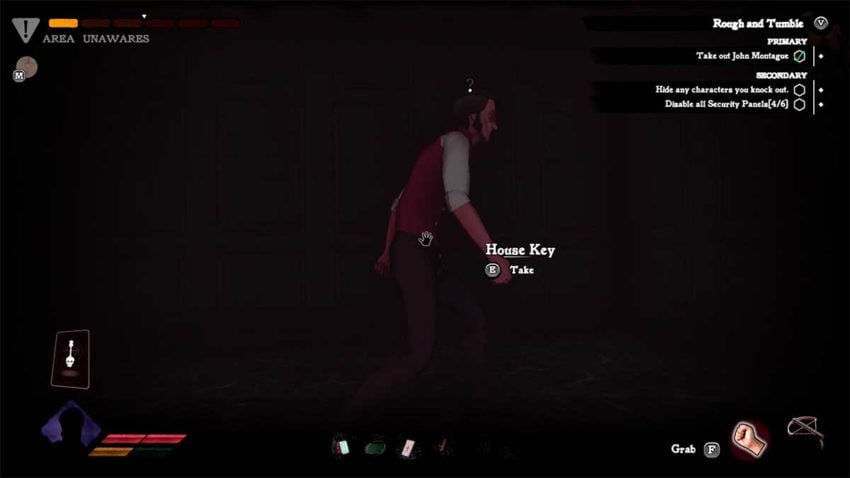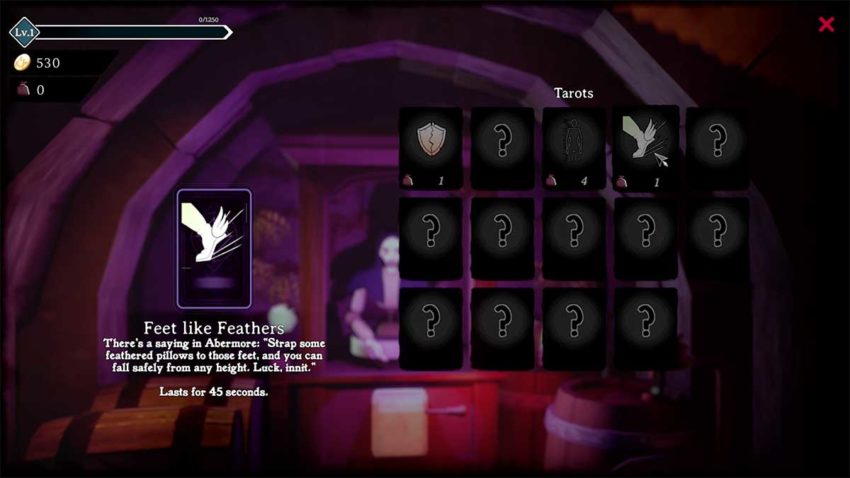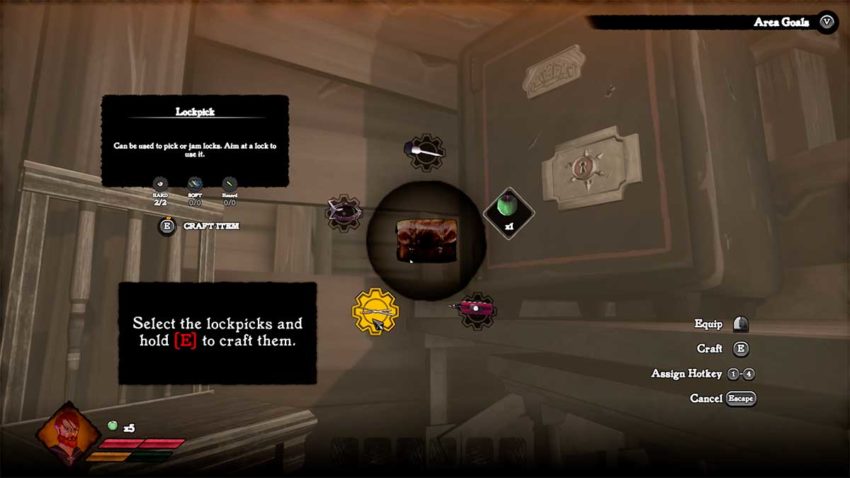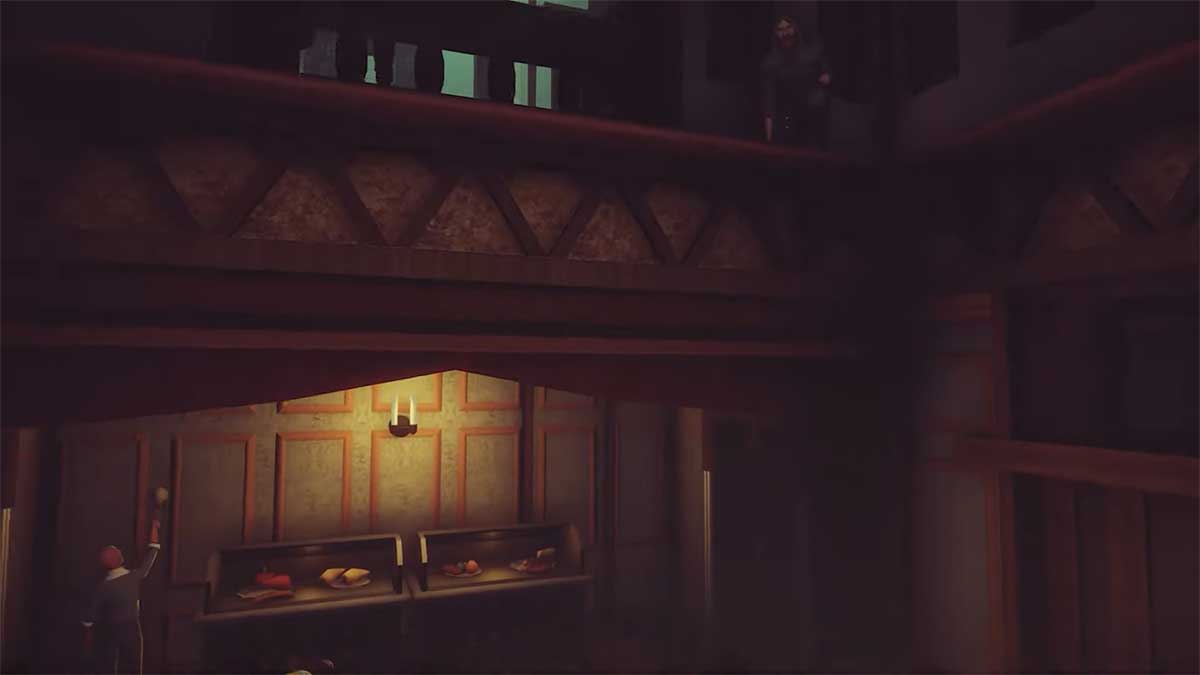There’s an undeniably great game lurking just under the surface in Abermore. Inspired by the likes of Dishonored, it takes concepts like The Outsider’s gifts and sandbox levels and mutates them to fit a unique formula through Tarot Cards and condensed open-ended heists. It’s just too bad that in its current state, the game is packed with so many bugs that it feels broken. We can’t help thinking that the true Abermore you can feel in the game’s undertones will never see the light of day.
Well-realized ideas

At the heart of Abermore is a genuinely impressive game. Players begin their journey as a stowaway on a ship. After a brief tutorial, in which you’re introduced to the god of thieves, Lady Luck, everything is thrown into chaos. It’s reminiscent of Dishonored in so many ways, from the way you’re taught basic actions through what feels like a small dare, to the impossibly strong enemies you must sneak past while armed with nothing but a magic Tarot Card.
From there, you’re introduced to the rest of the cast, the lowest of the low in a stratified city that’s getting ready for the biggest feast of the year. You’re going to break into the biggest and most luxurious house on the day of the feast to pull off the greatest heist Abermore has ever seen. But you need to learn your craft first.
Over the course of the next seventeen days, you pick and choose jobs by speaking to people around Abermore and the Black Market, the place where the scum, poor, and unfortunate from around the city all wash up eventually. Some jobs can be completed on any night, while others are only available on the day you get them. These are randomized with each playthrough, meaning every time you restart you’ll have a unique campaign.
You can complete one job per night, earning you gold to spend on equipment to help in future jobs and the big heist you have ahead of you. As your arsenal of lockpicks, crossbows, and time bombs grows, you’ll take on more challenging jobs. Some even have specific requirements, such as blasting through a wall to steal the target item.
Learn to be the ultimate thief

The game does a fantastic job of making you feel as though you’re getting better at sneaking and stealing. This is aided by the Tarot Cards, which give you a single-use power such as invisibility or teleportation, that you pick up in jobs or buy with sacred offerings from Lady Luck’s incredibly creepy fortune telling machine.
NPCs are smart enough to give you a challenge, but not so much that they can work out when something is amiss. For example, you can alert an entire house by running around making lots of noise, but if you carefully subdue and hide the bodies of everyone in the property, you can eventually do whatever you want.
If you’re too loud, mechanical soldiers called Hounds are summoned, but we never had an issue with them because we were always quiet and methodical. There are easily enough vents and alternate routes to use around all the locations you’ll enter that you can reach every room, regardless of the equipment you have with you. This allows for many dynamic approaches to each job. It’s like any stealth game though, rush and you’ll be punished.
Being slow and considering every action did mean that jobs ended up taking up to an hour sometimes. We’d argue this is a good thing. In that hour we were able to subdue all guards or house staff, take most if not all valuable objects to maximize the gold we’d earn, pick every lock, and discover every Tarot Card. This feels rewarding because everything you claim in a mission helps you prepare for the game’s final brutal challenge, the feast heist.
As you might be able to tell, it takes the ideas presented in Dishonored and twists them into a new format that allows for almost endless replayability without repetition in the missions. The Tarot Cards are what separates it though. Since these magical powers can only be used once, you’re forced to wait until it’s absolutely necessary to pop them. This makes them more like get out of jail cards as opposed to superpowers, but it grounds the game and reminds you that you’re a lowly thief trying to make their way in the world run by the rich.
An impossible trudge through bugs

Unfortunately, Abermore is mired at almost every turn by bugs and glitches. This is something everyone who has played the game has experienced, and we can’t in good conscience recommend it until it’s in better shape. Some bugs are easy to deal with and are purely visual, like clipping through the floor. We’d be willing to live with those superficial bugs, but it’s the ones that make you waste your time that hit us hardest.
We encountered at least one game-breaking bug per job that forced us to quit the game and restart the day. Twice these bugs came at the end of a heist, meaning we’d wasted hours of our time. We had to repeat all of our work over because progress is only saved once you end a job. It’s maddening, and honestly such a disappointment considering how good the game could be without these constant issues.
On the day of release, one of the game’s developers explained in a thread on Twitter that most of the team had to start new jobs out of necessity after it was announced. We don’t know the ins and outs, but the end result is that Abermore is broken and likely won’t ever be fixed, and that’s a real shame.
Abermore’s story is very much a metaphor for the game itself. It’s the Black Market that sits under the city, collecting the dregs of society that have been cast aside by the rich and powerful, much like how the bugs and glitches throw the true joy of this game out of focus. If Abermore is ever fixed, it could rise to steal back the spotlight from its glitches like players stealing from the rich on their feast night. It’s going to take more than a few Tarot Cards to get the job done though.







Published: Apr 11, 2022 12:56 pm